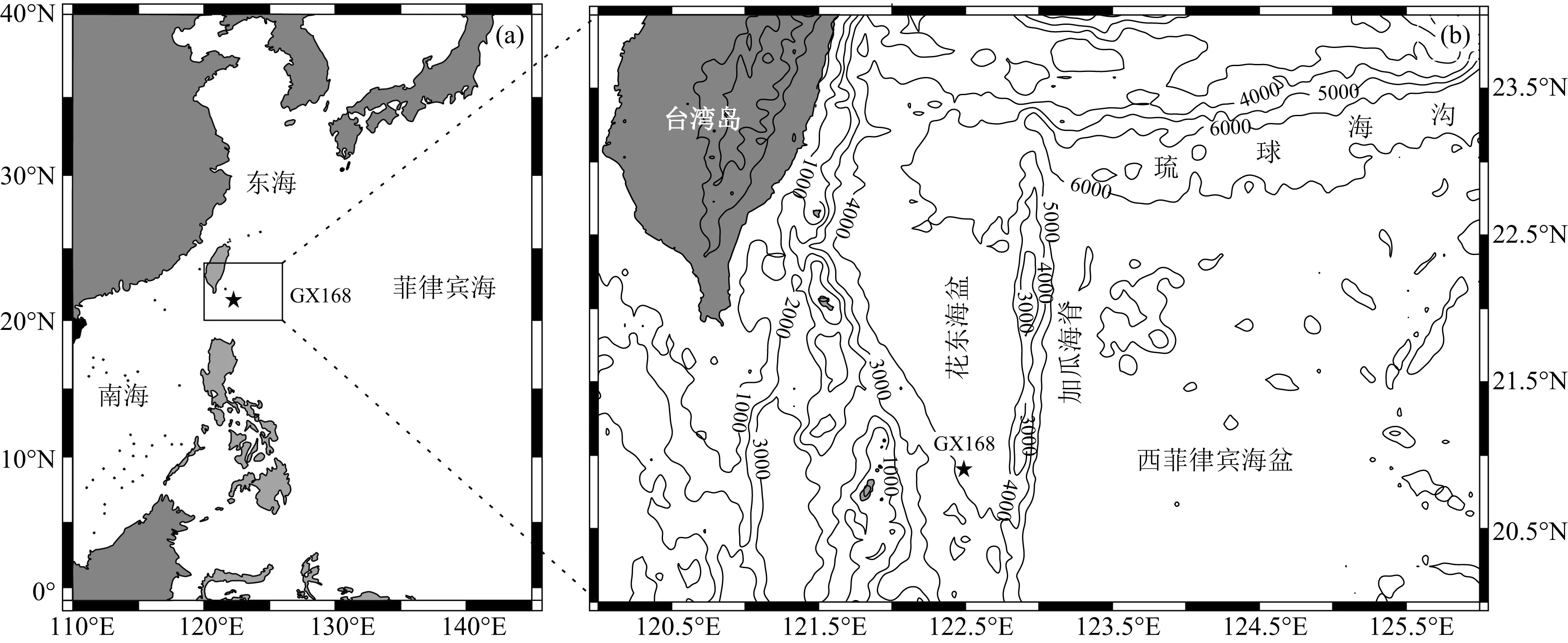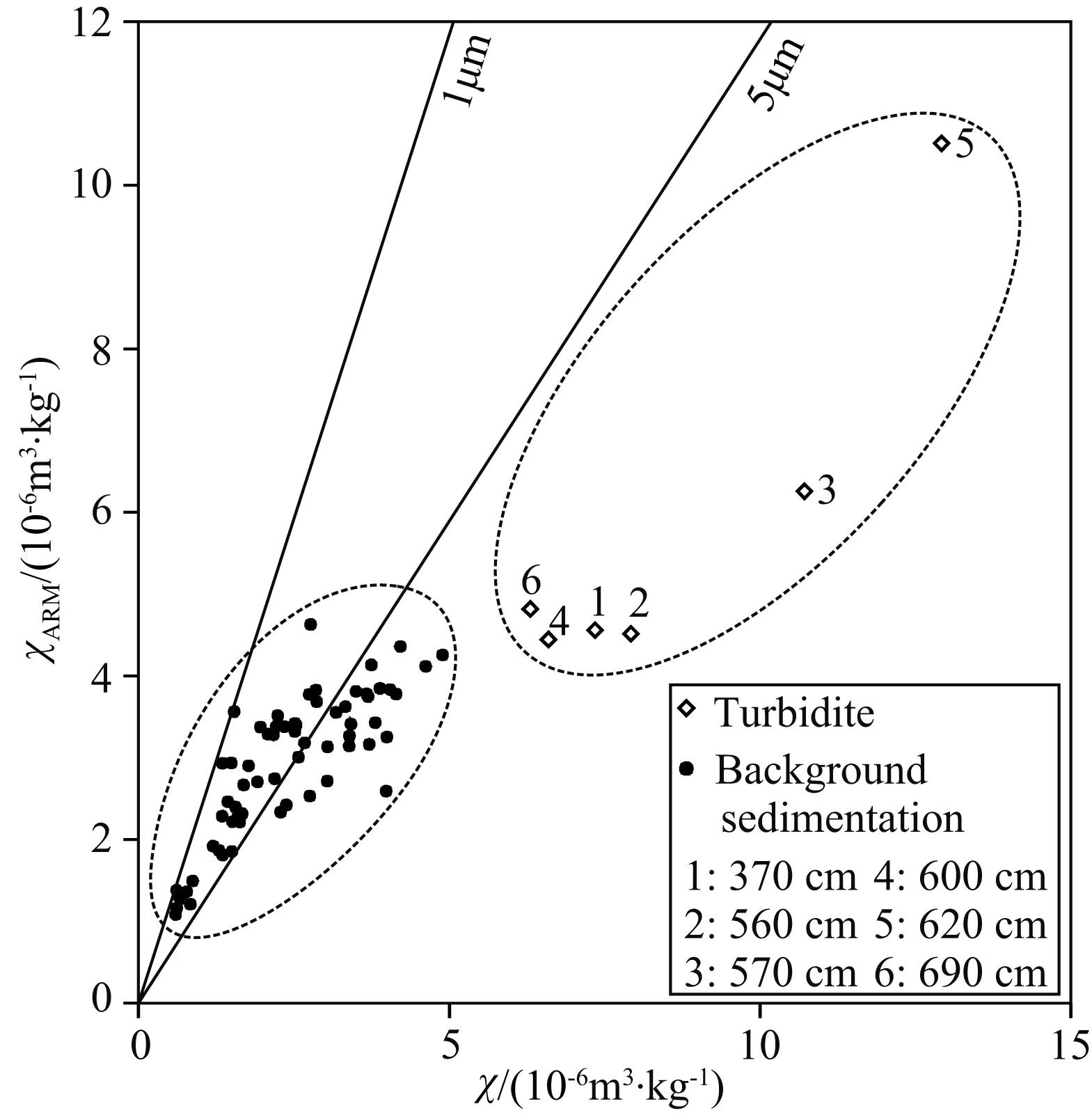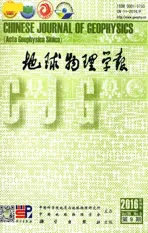花东海盆浊流沉积的磁性特征及其环境意义
2016-11-16李波王艳钟和贤张江勇李顺李学杰高红芳
李波, 王艳, 钟和贤, 张江勇, 李顺, 李学杰, 高红芳
1 国土资源部海底矿产资源重点实验室, 广州海洋地质调查局, 广州 510075 2 广东省有色地质勘查院, 广州 510080
花东海盆浊流沉积的磁性特征及其环境意义
李波1, 王艳2, 钟和贤1, 张江勇1, 李顺1, 李学杰1, 高红芳1
1 国土资源部海底矿产资源重点实验室, 广州海洋地质调查局, 广州 510075 2 广东省有色地质勘查院, 广州 510080
对取自台湾以东花东海盆GX168孔的浊流沉积物进行系统的岩石磁学研究,揭示其沉积学和岩石磁学特征,分析其物源和形成机制.研究结果显示,剖面上共识别出12层浊流沉积物,其分布存在规律,下部350~700 cm共发育11层浊流沉积物,而0~350 cm仅出现1层浊流沉积物.浊流沉积物粒径明显较背景沉积物粗,石英、长石含量更高,底部与下伏背景沉积呈突变接触,顶部与上覆背景沉积呈渐变接触,内部发育典型的正粒序韵律结构.浊流沉积物和背景沉积物具有相似的磁学特征,两者均以磁铁矿为主要载磁矿物类型,且磁铁矿颗粒均以准单畴和多畴颗粒为主.同时,两者也存在一定差异,浊流沉积物中磁铁矿较背景沉积物更为富集,磁化率和饱和等温剩磁更强,磁铁矿粒径更粗,这与浊流沉积物原始沉积区更靠近物源区有关.花东海盆浊流沉积形成的诱发机制可能是末次冰期以来频发的海平面波动造成陆坡之上沉积物重力失稳,导致陆坡沉积物向海盆搬运.
花东海盆; 浊流; 磁学特征; 海平面波动
1 引言
浊流(Turbidity current)是重力流的一种特殊形式,是一种在水体底部形成的高速湍流状态的混浊流体,由水和大量悬浮泥砂混合组成(Kneller and Buckee, 2000).作为一种重要的地质营力,浊流将大量浅海物质搬运至深海再沉积,在浅海-深海的物质交换与循环中发挥重要作用.浊流一方面为深海生态群带来大量的陆源营养盐,现场直接观测证实浊流在维持深海峡谷繁盛的生态系统中发挥重要作用(徐景平, 2013);另一方面会对沿途的底栖生物群落造成严重破坏,同时危及海底电缆等现代化设施(Hsu et al., 2008).而随着油气勘探的深入,人们发现浊流沉积体系同样是一类重要的油气储层(龚建明等, 2005;Schneider et al., 2012).因此,浊流沉积受到国内外学者广泛关注,成为沉积学中的研究热点(Mulder and Syvitski, 1995;Shanmugam, 1997, 2000;方爱民等, 1998;姜辉, 2010;Huang et al., 2012;高红灿等, 2012;徐景平, 2014).
自然界中磁性矿物无处不在,其来源、搬运和沉积受气候环境控制,利用岩石磁学手段识别沉积物中磁性矿物的类型、含量和粒径,即可追踪磁性颗粒的物质来源、搬运与沉积等过程,从而反演气候环境变化.经过几十年的发展,在海洋沉积物的环境磁学研究方面取得了诸多成果(Watkins and Maher, 2003;Kumar et al., 2005;孟庆勇和李安春, 2008;Peters et al., 2010;Liu et al., 2012;欧阳婷萍等, 2014).近20年来,国内外报导了一些利用磁学手段研究浊流性质及其环境意义的实例:李杰森等(1999)对云南抚仙湖现代浊流沉积物的磁化率研究发现,沉积物剖面中磁化率峰值与地震形成的浊流层具有良好的对应关系,表明通过磁化率可揭示浊流的发育历史;葛淑兰等(2012)对日本海Ulleung盆地浊流沉积物的磁化率各向异性(AMS)研究表明,浊流沉积物样品三轴主方向杂乱,证明AMS可作为沉积物剖面上浊流的识别手段之一;Anchuela等(2011)对始新世受构造作用影响的浊积岩研究表明,鲍马序列不同层位沉积岩的AMS方向相似.这些研究表明磁学手段在浊积物/岩的识别和沉积学特征研究上有效可行,但目前对浊流沉积详细的环境磁学研究却鲜见报道,浊流沉积物与原地背景沉积物的磁学性质是否存在差异、有何差异尚不清楚.
西菲律宾海陆架狭小,四周被海沟包围,陆坡陡,具备形成浊流的潜力,近年来的海洋地质调查与研究工作证实了西菲律宾海及邻区沉积物中发育浊流沉积(李军等, 2005;党皓文等, 2009;仇晓华等, 2012).因此,本文选取台湾岛东侧花东海盆GX168孔为研究对象,通过详细的岩石磁学分析,弄清浊流沉积物和背景沉积物各自的磁学性质、两者之间的差异及环境意义,并结合区域地质背景分析浊流事件的成因.
2 样品采集和实验方法
GX168孔重力活塞样取自台湾岛东侧花东海盆西南角,其位于吕宋火山岛弧东侧,加瓜海脊西侧(图1),水深4409 m,岩心长700 cm.柱状样岩心沿中轴线剖开后,用边长2 cm的无磁性立方体样品盒对其中一半岩心取样,间距为10 cm,共采集磁学样品71个.
样品称重后依次进行如下环境磁学项目测量:(1)利用卡帕桥MFK1-FA多频磁化率仪测量所有样品的低频(976 Hz)和高频(15616 HZ)磁化率,记为LF和HF,然后计算频率磁化率百分数fd%=(LF-HF)/LF×100%;(2)样品在100 mT交变场叠加0.05 mT的直流偏置场下获得非磁滞剩磁(ARM);(3)利用2G Enterprise 脉冲磁化仪获得外场为1 T条件下的等温剩磁(将之视为饱和等温剩磁(SIRM)),之后将样品在300 mT反向场中磁化,得到IRM-300mT,定义S-ratio=-IRM-300 mT/SIRM,HIRM=(SIRM+IRM-300 mT)/2(Thompson and Oldfield, 1986;Evans and Heller, 2003);(4)上述所有剩磁测量均在2G-760 U-Channel 岩石超导磁力仪上完成,灵敏度为2×10-12Am2;(5)利用卡帕桥MFK1-FA多频磁化率仪及CS-3温控装置测量代表性样品的磁化率随温度变化曲线(κ-T曲线):粉末样品在氩气环境下自室温以11 ℃·min-1速率升温至700 ℃后,以相同速率冷却至室温,测量频率为976 Hz,磁场强度为200 A·m-1;(6)在Micromag 3900振动磁力仪上完成代表性样品的磁滞参数(饱和磁化强度Ms,饱和剩余磁化强度Mrs,矫顽力Bc和剩磁矫顽力Bcr)以及IRM获得曲线测量(最大场设定为1 T,步长为5 mT).所有磁学实验均在中国科学院地质与地质物理研究所古地磁与年代学实验室完成.

图1 GX168孔位置和西菲律宾海海底地形(a) 底图改绘自Smith和 Sandwell (1997); (b) 水深数据引自SRTM30_PLUS V6.0 (Becker et al., 2009).Fig.1 Location of core GX168 and submarine relief of the West Philippine Sea(a) The base map was modified from Smith and Sandwell (1997); (b) The bathymetric data was cited from SRTM30_PLUS V6.0 (Becker et al., 2009).
3 结果与分析
3.1 浊流沉积发育特征
由于浊流与碎屑流的相似性,导致实际研究中一部分碎屑流或底流被误认为是浊流沉积(高红灿等, 2012),因此对浊流沉积的正确鉴别至关重要.浊流沉积与碎屑流沉积外在特征最显著的区别是浊流沉积具正粒序韵律结构,底部为突变接触而顶部为渐变接触(Shanmugam, 1997, 2000);而碎屑流沉积一般具上、下两层韵律结构,即下部发育具平行碎屑结构的层流段,上部发育具有块状层理的“刚性”筏流段,顶底均为突变接触(王德坪,1991;Bridge and Demicco, 2008).
研究区位于深海盆地,水深超过4000 m,广义而言,静水泥质沉积可作为背景沉积(正常沉积),其他类型沉积均可视为事件沉积(非正常沉积),它们具有特殊的形成机制与沉积模式.参照张富元等(2012)的分类命名方案,GX168孔沉积物中背景沉积主要是灰色细粒远洋粘土,以粉砂和粘土粒级颗粒为主,砂含量极少(通常小于1%),镜下未见钙质生物壳体,为典型的深海沉积.在这些深海沉积中共识别出12层事件沉积(仅在其中6层采集了磁学样品),其在剖面上的分布存在一定规律(图2a):0~350 cm事件沉积发育明显较少,仅见1层事件沉积;350~700 cm事件沉积发育频率明显增大,共识别11层事件沉积.事件沉积单层厚度2~9 cm,其底部冲刷侵蚀下伏背景沉积,两者呈突变接触,接触面清晰截然.事件沉积内部发育正粒序韵律结构,顶部与上覆背景沉积呈渐变接触,接触面不明显(图2b).以上特征可确定这些事件沉积为浊流成因.在物质组成上,浊流沉积物颜色相对背景沉积物稍浅,颗粒粒径明显更粗,以砂为主,砂感强,粉砂、粘土颗粒含量明显降低,定名为粉砂质砂-砂(Folk et al., 1970).在浊流内部,从底到顶,颗粒粒径明显减小,由砂渐变成粉砂质砂(即正粒序结构,图2).浊流沉积物在镜下可见无色—白色粗粒石英、长石颗粒含量明显较上下层位(背景沉积)增多,这正是导致浊流沉积物颗粒相对背景沉积物颜色变浅、颗粒变粗的原因,这一特征与南海南部巽他陆坡底部MD05-2895孔的浊流沉积物相似(赵玉龙等, 2011).此外,部分浊流层内可见少量—较丰富有孔虫壳体,这些特征均反映浊积物来自相对浅水的海底沉积,并非原地深海沉积.
3.2 磁性矿物的类型


图3 GX168孔典型沉积物样品的IRM获得曲线及反向场退磁曲线是样品在正向磁场中获得剩磁为SIRM值一半时的磁场,星号标记的样品取自浊流层(下同),括号内标注了样品的深度(下同),结果显示浊流沉积物和背景沉积物无明显差别.Fig.3 Isothermal remanent magnetization (IRM) acquisition curves and backfield acquisition curves of typical samples of core GX168 sediments is defined as the magnetic field strength required to magnetize a sample to one-half of its saturation isothermal remanent magnetization. Sample marked with an asterisk was taken from turbidite layer (similarly hereinafter). The depth of the sample is shown within the parentheses (similarly hereinafter). The results indicate that there are no significant differences between the turbidite and background sedimentation.
不同的磁性矿物在加热/冷却过程中,其磁化率值会随温度变化(κ-T曲线)而表现不同特征,根据这些特征可判断样品中磁性矿物的类型及矿物相之间的转变(Hrouda, 1994;Dunlop and Özdemir, 1997;Liu et al., 2005).GX168孔典型沉积物样品的κ-T曲线如图4所示,可分为两类.第一类样品(图4a)加热曲线的磁化率一直上升,在300 ℃左右时达到峰值,之后随温度升高而迅速下降,但在500 ℃之后再次上升,并在560 ℃左右形成第二个峰值(可能是细粒单畴(SD)颗粒磁铁矿解阻形成的Hopkinson峰),之后随温度升高而迅速下降,并在磁铁矿的居里温度点(580 ℃)趋于零,冷却曲线显示其在580 ℃左右磁化率开始增加,其终止磁化率同样比初始磁化率高很多,表明在加热过程中有新的磁铁矿形成.第二类样品(图4b—4f)加热曲线的磁化率一直上升,并在350 ℃左右达到峰值,之后随温度升高而迅速下降,并在580 ℃趋于零,其冷却曲线显示在580 ℃左右磁化率开始增加,其终止磁化率比初始磁化率高很多,表明在加热过程中有新的磁铁矿形成.所有样品加热和冷却过程均显示不可逆特征,冷却后的磁化率值明显高于初始值,指示样品在加热过程中生成了新的亚铁磁性矿物,这些新生成的磁铁矿可能来自于样品中含铁硫化物、含铁硅酸盐或粘土矿物的受热转换(Ellwood et al., 2007;杨小强等, 2007;欧阳婷萍等, 2014).
磁滞回线形态和闭合特征可用来判断磁性颗粒类型.图5是GX168孔浊流沉积物与背景沉积物代表性样品经过顺磁校正后的磁滞回线.总体而言,全部样品的磁滞回线形态非常类似,差别很小.所有样品磁滞回线的腰均很细,即Bc较小,在100 mT外加磁场下磁滞回线已经完全闭合,表明样品中载磁矿物主要是亚铁磁性矿物,基本不含硬磁性矿物(Dunlop and Özdemir, 1997).
3.3 磁性矿物的粒径
传统磁学理论认为,磁畴处于SP/SD阈值区域的颗粒,其磁化率值与弛豫时间有关,弛豫时间越短,颗粒振动越快.当观测的时间尺度小于颗粒振动周期时,则观测比颗粒振动快,颗粒显示稳定单畴的信息,磁化率值低;反之,当观测的时间尺度大于其颗粒振动周期,则观测比颗粒振动慢,颗粒表现出超顺磁特征,磁化率值高.因此,不同频率下测定的磁化率差值可用来表征磁畴位于SP/SD阈值区域内磁性颗粒的含量(刘青松和邓成龙, 2009;徐新文等, 2012).GX168孔沉积物样品的fd%十分稳定,分布范围为1.55~3.28,平均值2.18,浊流沉积物和背景沉积物差别不大,表明GX168孔所有沉积物样品中处于SP/SD阈值区域的颗粒含量均很低.

图4 GX168 孔典型沉积物样品的κ -T曲线样品在氩气环境下以11 ℃·min-1速率加热到700 ℃后以相同速率冷却至室温,所有样品的κ -T曲线可分为两类:a为一类,b-f为一类.Fig.4 κ -T curves of typical samples of core GX168 sediments All samples were heated from room temperature to 700 ℃ at a heating rate of 11 ℃·min-1 and then cooled at the same rate. κ -T curve of all samples could be divided into two categories: sample (a) and the remanent five samples (b—f).

图5 GX168孔典型沉积物样品的磁滞回线Fig.5 Magnetic hysteresis loops of typical samples of core GX168 sediments

图6 GX168孔沉积物样品的King图Fig.6 King plot of core GX168 sediments

图7 GX168孔典型沉积物样品的Day图Fig.7 Day plot of typical samples of core GX168 sediments
当样品中主要载磁矿物为磁铁矿时,可用King图(King et al., 1982)或Day图(Day et al., 1977)来确定磁性矿物的颗粒大小.GX168孔沉积物样品的King图(图6)投影表明大部分样品中磁性颗粒的粒径分布较集中,粒径均大于1 μm,浊流沉积物样品和背景沉积物样品分布在两个明显不同的区域,浊流沉积物样品的粒径明显更粗一些,均大于5 μm.将经过顺磁校正的样品磁滞参数投影到Dunlop(2002)修订过的Day图中发现,浊流样品和背景沉积物样品的分布相似,两者各有一部分样品落在PSD及MD区域,但可看出浊流样品的颗粒明显更粗(图7),与King 图投影结果一致.
3.4 磁性参数剖面变化
S-ratio可很好地反映样品中软磁组分和硬磁组分的相对含量.S-ratio越接近1,载磁矿物中软磁组分的相对含量越高;反之,随着S-ratio降低,硬磁组分的相对含量增多(Thompson and Oldfield, 1986).GX168孔沉积物样品的S-ratio普遍介于0.96~1.00之间,平均值0.98,表明样品中载磁矿物以低矫顽力软磁性组分(亚铁磁性矿物)为主;而且S-ratio随深度增加变化较小(图8),浊流沉积物和背景沉积物之间并无明显差异,指示整个剖面上载磁矿物组分十分稳定.
HIRM主要与硬磁矿物(如赤铁矿、针铁矿等)的含量有关,硬磁组分的绝对含量越高,HIRM值越大(Thompson and Oldfield, 1986).GX168孔沉积物样品的HIRM最小值为4.22×10-7Am2·kg-1,最大值为5.43 ×10-4Am2·kg-1,平均值为 1.80×10-4Am2·kg-1,表明赤铁矿类硬磁性矿物的含量整体较低.从剖面上看,HIRM变化规律不明显,与其他磁性参数,特别是与的相关性较差,表明的变化与硬磁组分含量关系不大.而浊流沉积物样品和背景沉积物样品的HIRM并未表现出明显差异,表明两者中赤铁矿等硬磁矿物的绝对含量均较低,差别不大,与S-ratio揭示的规律一致.


图8 GX168孔磁性参数剖面变化图阴影部分标示浊流发育层位,共12层;星号表示样品取自于浊流层(共6层,采样深度分别是370 cm、560 cm、570 cm、600 cm、620 cm与690 cm),未标星号的浊流层未取样;5×10-6 m3·kg-1为浊流沉积物和背景沉积物样品的磁化率值分界线.Fig.8 Stratigraphic variation of magnetic parameters of core GX168Twelve turbidite layers are marked by shading. The asterisk indicates that the samples were taken from the turbidite layers (the depths of samples are 370 cm, 560 cm, 570 cm, 600 cm, 620 cm and 690 cm, respectively). No sample was collected from the turbidite layer without an asterisk marked. 5×10-6 m3·kg-1 is the boundary of magnetic susceptibility between the turbidite and background sedimentation.

图9 GX168孔沉积物的SIRM与 相关性关系图Fig.9 Linear correlation between SIRM and of core GX168 sediments


4 讨论
4.1 浊流沉积与背景沉积磁性特征差异及原因
利用磁学性质分析沉积物蕴含的环境意义,首先必须弄清沉积物中磁性矿物的成因,因为碎屑成因的磁性矿物才具有物源信息,而生物成因磁性矿物形成于早期成岩过程中,不代表原始磁学特征.Oldfield(1994)对湖泊和海洋近岸沉积物中细粒亚铁磁性矿物的成因深入研究后,提出采用ARM/fd和ARM/两个参数组合判别磁铁矿成因:如果ARM/和ARM/fd均很大,尤其是后者大于1000时,样品中的磁铁矿主要由细菌生成.GX168孔包括浊流沉积物在内所有样品的ARM/介于0.57~2.32之间,平均值1.29,ARM/fd介于29.38~82.88之间,平均值58.36,两者均很低,尤其是后者远低于判别标准.因此,可认为GX168孔中磁性矿物为碎屑成因.而普遍较低的SIRM/(图8)表明钻孔沉积物中不含早期还原成岩作用形成的亚铁磁性硫化物(Peters and Dekkers, 2003),说明早期成岩作用对本钻孔沉积物的影响较小,基本保存了原始沉积信息.

浊流沉积物和背景沉积物在磁性矿物含量和粒径上存在显著差异(表1):表征磁性矿物含量的参数、SIRM和ARM显示浊流沉积物中磁性矿物含量明显较背景沉积物高,与抚仙湖现代浊流沉积物的特征相同(李杰森等, 1999);ARM/值、King图及Day图投影表明浊流沉积物中磁铁矿粒径明显大于背景沉积物.陆源物质通过河流搬运到海洋,然后在底流作用下分散到盆地中沉积.浊流沉积物原始沉积在相对更浅的陆架区,离陆源区更近,单位时间内“捕获”到的陆源物质通量更大(导致沉积物磁性增强),粒度也更粗;而背景沉积区因更远的搬运距离导致输入到沉积区磁性矿物的通量降低,粒径变细.浊流沉积物和背景沉积物具有相同的物源,因而磁性矿物的种类相同,而离物源区不同的距离导致了两者磁性矿物含量和粒径上的差异.在利用岩石磁学参数解释气候环境时必须注意沉积序列中浊流沉积层,否则可能会对剖面上的磁化率“异常高值”做出错误的解释.

表1 GX168孔浊流沉积与背景沉积磁学参数对比Table 1 The magnetism parameters of turbidite compared with background sedimentation of core GX168
4.2 浊流发育成因
浊流沉积是大陆边缘沉积物向深海区的搬运,必须满足一定条件才能形成.广义上讲,沉积重力流需满足四个条件:足够的水深、充足的物质、必要的坡度和触发机制.前两点是浊流发育的物质基础,第三点是维持浊流运动的动力来源.对海洋环境而言,浊流主要形成于陆棚坡折以下的相对深水区,特别是盆地中的三角洲前缘、洋盆中的海底峡谷口和平行于克拉通边缘的深海槽等环境(姜辉, 2010).最后一个条件尤为关键,是突发性外力对沉积物静力学不稳定破坏.前人研究表明,深海浊流形成的触发机制主要有海平面波动、地震、火山作用、海啸巨浪和风暴潮、天然气水合物泄露等,处于较陡地形之上的松散沉积物在上述这些事件发生时重力失稳,极易发生垮塌,顺着陆坡向深海区搬运,形成浊流沉积(Lee et al., 1996;Rothwell et al., 1998;方爱民等, 1998;党皓文等, 2009;姜辉, 2010;仇晓华等, 2012;Arai et al., 2013).GX168孔所在区域水深4409m,位于花东海盆西侧斜坡底部,距离吕宋火山岛弧不足30 km,距离台湾岛200 km,物质来源充足,其西侧的陆坡坡度很陡(图1),为浊流发育提供了极为有利的地形和必要的物质基础,只要外力触发,很容易形成浊流.
研究区位于欧亚板块与菲律宾海板块的碰撞地带,频发的火山活动似乎可触发浊流的形成.但GX168孔浊流沉积发育的临近层位并未发现火山灰堆积层,镜下观察也少见火山物质的踪影,因而构造运动导致的火山活动似乎与本区浊流形成的关系不大.对取自冲绳海槽南部A23孔中浊积层的研究表明,浊流可能主要由地震触发形成(李军等, 2005).花东海盆位于板块会聚、地震活动区,构造运动引起的频发地震可能是浊流形成的触发机制,但从浊流在剖面上的分布规律来看,350 cm以下浊流发育的频率明显要高于上部(0~350 cm),表明全新世以来浊流发育的频率明显变缓,上部沉积物未能响应近几十年来频发的地震(方兴义, 2014),因而地震触发机制还需更多资料的支持.对西菲律宾海吕宋岛岸外柱状样中浊流沉积研究表明,末次冰期以来海平面剧烈波动(Hanebuth et al., 2000)造成欠固结沉积物重力失稳是促发浊流形成的主要原因,低水位时期陆源物质堆积是必要条件,而海平面上升后造成的沉积物不稳定是触发因素之一(党皓文等, 2009;仇晓华等, 2012).赵玉龙等(2011)对南海南部巽他陆坡底部浊流沉积研究后,同样认为海平面波动是造成巽他陆坡上浊流形成的原因.本文由于缺乏有孔虫氧同位素曲线和放射性同位素年龄资料,因而无法详细探讨本区浊流沉积与海平面波动之间的联系,但GX168孔浊流发育的频率特征与菲律宾海西部吕宋岛岸MD98-2188孔揭示的浊流发育规律非常相似(党皓文等, 2009),均是沉积物剖面下部浊流发育频繁,而上部浊流发育频率明显降低.因此,海平面变化导致本区浊流发育的可能性最大.末次冰期以来,全球海平面波动十分频繁,发生了多期海平面快速升降事件,末次盛冰期时海平面最大下降甚至可达百米(Fairbanks, 1989; Hanebuth et al., 2000; Siddall et al., 2003),导致西菲律宾海及台湾岛东侧陆坡地区浊流沉积频繁发育,但进入全新世后,全球海平面逐渐趋于稳定,浊流发育的频率随之减缓.
5 结论
本文对采自台湾岛东侧花东海盆南部的GX168孔浊流沉积物进行详细的岩石磁学分析,主要得出以下结论:
(1) GX168孔发育12层粉砂质砂—砂层,以砂为主,粉砂、粘土相对较少,具典型的正粒序韵律结构,沉积物粒径明显较背景沉积物(粘土)粗,底部与下伏沉积呈突变接触,顶部与上覆沉积呈渐变接触,鉴定为浊流沉积.镜下观察表明浊流沉积物相对背景沉积物颜色变浅、粒径增大主要与粗粒石英、长石含量相对富集有关.
(2) 详细的岩石磁学分析表明,浊流沉积物和背景沉积物具有相似的磁学特征,表现在两者均以磁铁矿为主要载磁矿物类型,磁铁矿粒径均以PSD和MD颗粒为主.但两者也存在差异:浊流沉积物中磁铁矿的含量明显较背景沉积物富集,磁化率和饱和等温剩磁更强,磁性矿物粒径也更粗,与浊流原始沉积区更靠近物源有关.两者较大的磁学性质差异在进行气候环境解释时必须引起重视.
(3) 花东海盆浊流沉积形成的诱发机制可能是末次冰期以来频发的海平面波动,海平面波动造成陆坡之上松散沉积物重力失稳,导致陆坡区沉积物向海盆搬运.
致谢 岩石磁学测试得到了中国科学院地质与地球物理研究所古地磁与年代学实验室刘青松和周灿芬老师的协助,审稿专家提出了宝贵意见,在此一并感谢!
Arai K, Naruse H, Miura R, et al. 2013. Tsunami-generated turbidity current of the 2011 Tohoku-Oki earthquake.Geology, 41(11): 1195-1198, doi: 10.1130/G34777.1.
Becker J J, Sandwell D T, Smith W H F, et al. 2009. Global bathymetry and elevation data at 30 arc seconds resolution: SRTM30_PLUS.MarineGeodesy, 32(4): 355-371.
Bridge J S, Demicco R V. 2008. Earth Surface Processes, Landforms and Sediment Deposits. Cambridge: Cambridge University Press.
Dang H W, Jian Z M, Bassinot F. 2009. Turidite deposition of the Last Glacial Stage in the Western Philippine Sea and its paleoenvironmental implications.QuaternarySciences(in Chinese), 29(6): 1078-1085, doi: 10.3969/j.issn.1001-7410.2009.06.09.Dankers P. 1981. Relationship between median destructive field and remanent coercive forces for dispersed natural magnetite, titanomagnetite and hematite.GeophysicalJournalInternational, 64(2): 447-461, doi: 10.1111/j.1365-246X.1981.tb02676.x. Day R, Fuller M, Schmidt V A. 1977. Hysteresis properties of titanomagnetites: Grain-size and compositional dependence.PhysicsoftheEarthandPlanetaryInteriors, 13(4): 260-267, doi: 10.1016/0031-9201(77)90108-X.
Dunlop D J, Özdemir Ö. 1997. Rock Magnetism: Fundamentals and Frontiers. Cambridge: Cambridge University Press.
Dunlop D J. 2002. Theory and application of the Day plot (Mrs/MsversusHcr/Hc) 1. Theoretical curves and tests using titanomagnetite data.JournalofGeophysicalResearch, 107(B3): 2056, doi: 10.1029/2001JB000486. Ellwood B B, Brett C E, Macdonald W D. 2007. Magnetostratigraphy susceptibility of the Upper Ordovician Kope Formation, Northern Kentucky.Palaeogeography,Palaeoclimatology,Palaeoecology, 243(1-2): 42-54, doi: 10.1016/j.palaeo.2006.07.003. Evans M E, Heller F. 2003. Environmental Magnetism: Principles and Applications of Enviromagnetics. London: Academic Press. Fairbanks R G. 1989. A 17,000-year glacio-eustatic sea level record: Influence of glacial melting rates on the Younger Dryas event and deep-ocean circulation.Nature, 342(6250): 637-642, doi: 10.1038/342637a0.
Fang A M, Li J L, Hou Q L. 1998. Sedimentation of turbidity currents and relative gravity flows: A review.GeologicalReview(in Chinese), 44(3): 270-280.
Fang X Y. 2014. The time-space symmetry and the tendency judgmentMs≥7.0 earthquake in Philippines.JournalofNorthwestNormalUniversity(NaturalScience) (in Chinese), 50(1): 110-114.Fassbinder J W E, Stanjek H. 1994. Magnetic properties of biogenic soil greigite (Fe3S4).GeophysicalResearchLetters, 21(22): 2349-2352, doi: 10.1029/94GL02506.
Folk R L, Andrews P B, Lewis D W. 1970. Detrital sedimentary rock classification and nomenclature for use in New Zealand.NewZealandJournalofGeologyandGeophysics, 13(4): 937-968, doi: 10.1080/00288306.1970.10418211.
Gao H C, Zheng R C, Wei Q L, et al. 2012. Reviews on fluid properties and sedimentary characteristics of debris flows and turbidity currents.AdvancesinEarthScience(in Chinese), 2012, 27(8): 815-827.
Ge S L, Shi X F, Liu Y G, et al. 2012. Turbidite and bottom-current evolution revealed by anisotropy of magnetic susceptibility of redox sediments in the Ulleung Basin, Sea of Japan.ChineseScienceBulletin, 57(6): 660-672. Gong J M, Zhang L, Chen J W, et al. 2005. A favorable reservoir for gas hydrate found in ODP Leg 204: Turbidite.Geoscience(in Chinese), 19(1): 21-25, doi: 10.3969/j.issn.1000-8527.2005.01.003.
Hanebuth T, Stattegger K, Grootes P M. 2000. Rapid flooding of the sunda shelf: A late-glacial sea-level record.Science, 288(5468): 1033-1035, doi: 10.1126/science.288.5468.1033.
Hrouda F. 1994. A technique for the measurement of thermal changes of magnetic susceptibility of weakly magnetic rocks by the CS-2 apparatus and KLY-2 Kappabridge.GeophysicalJournalInternational, 118(3): 604-612, doi: 10.1111/j.1365-246X.1994.tb03987.x.
Hsu S K, Kuo J, Lo C L, et al. 2008. Turbidity currents, submarine landslides and the 2006 Pingtung Earthquake off SW Taiwan.Terrestrial,AtmosphericandOceanicSciences, 19(6): 767-772.
Huang H Q, Imran J, Pirmez C. 2012. The depositional characteristics of turbidity currents in submarine sinuous channels.MarineGeology, 329-331: 93-102, doi: 10.1016/j.margeo.2012.08.003.
Jiang H. 2010. Dynamical mechanism and depositional responses of turbidity current sedimentation.Oil&GasGeology(in Chinese), 31(4): 428-435.
King J, Banerjee S K, Marvin J, et al. 1982. A comparison of different magnetic methods for determining the relative grain size of magnetite in natural materials: Some results from lake sediments.EarthandPlanetaryScienceLetters, 59(2): 404-419, doi: 10.1016/0012-821X(82)90142-X.
Kneller B, Buckee C. 2000. The structure and fluid mechanics of turbidity currents: A review of some recent studies and their geological implications.Sedimentology, 47: 62-94, doi: 10.1046/j.1365-3091.2000.047s1062.x.
Kumar A A, Rao V P, Patil S K, et al. 2005. Rock magnetic records of the sediments of the eastern Arabian Sea: Evidence for late Quaternary climatic change.MarineGeology, 220(1-4): 59-82, doi: 10.1016/j.margeo.2005.06.038.
Lee H J, Chough S K, Yoon S H. 1996. Slope-stability change from late Pleistocene to Holocene in the Ulleung Basin, East Sea (Japan Sea).SedimentaryGeology, 104(1-4): 39-51, doi: 10.1016/0037-0738(95)00119-0.
Li J, Gao S, Sun Y B. 2005. Grain-size characteristics of turbidite sediments in core A23 from the Southern Okinawa Trough.MarineGeology&QuaternaryGeology(in Chinese), 25(2): 11-16.
Li J S, Song X L, Sun Y L, et al. 1999. The magnetic susceptibility measurements of turbidity current sediments from Fuxian-Lake of Yunnan Province, China and their correlations with earthquakes.ActaSeismologicaSinica(in Chinese), 21(1): 83-88. Liu Q S, Deng C L, Yu Y, et al. 2005. Temperature dependence of magnetic susceptibility in an argon environment: implications for pedogenesis of Chinese loess/palaeosols.GeophysicalJournalInternational, 161(1): 102-112, doi: 10.1111/j.1365-246X.2005.02564.x.
Liu Q S, Deng C L. 2009. Magnetic susceptibility and its environmental significances.ChineseJournalofGeophysics(in Chinese), 52(4): 1041-1048, doi: 10.3969/j.issn.0001-5733.2009.04.021.
Liu Q S, Roberts A P, Larrasoaa J C, et al. 2012. Environmental magnetism: Principles and applications.ReviewsofGeophysics, 50(4): RG4002, doi: 10.1029/2012RG000393. Lowrie W. 1990. Identification of ferromagnetic minerals in a rock by coercivity and unblocking temperature properties.GeophysicalResearchLetters, 17(2): 159-162, doi: 10.1029/GL017i002p00159.Maher B A. 2007. Environmental magnetism and climate change.ContemporaryPhysics, 48(5): 247-274, doi:10.1080/00107510801889726. Maher B A. 2011. The magnetic properties of Quaternary aeolian dusts and sediments, and their palaeoclimatic significance.AeolianResearch, 3(2): 87-144, doi: 10.1016/j.aeolia.2011.01.005.
Meng Q Y, Li A C. 2008. Brief reviews on environmental magnetism in marine sediment.MarineEnvironmentalScience(in Chinese), 27(1): 86-90.
Mulder T, Syvitski J P M. 1995. Turbidity currents generated at river mouths during exceptional discharges to the world oceans.TheJournalofGeology, 103(3): 285-299.
Oldfield F. 1994. Toward the discrimination of fine-grained ferrimagnets by magnetic measurements in lake and near-shore marine sediments.JournalofGeophysicalResearch, 99(B5): 9045-9050, doi: 10.1029/93JB03137. Ouyang T P, Tian C J, Zhu Z Y, et al. 2014. Magnetic characteristics and its environmental implications of core YSJD-86GC sediments from the southern South China Sea.ChineseScienceBulletin, 59(25): 3176-3187.
Peters C, Austin W E N, Walden J, et al. 2010. Magnetic characterisation and correlation of a Younger Dryas tephra in North Atlantic marine sediments.JournalofQuaternaryScience, 25(3): 339-347, doi: 10.1002/jqs.1320.
Peters C, Dekkers M J. 2003. Selected room temperature magnetic parameters as a function of mineralogy, concentration and grain size.PhysicsandChemistryoftheEarth, 28(16-19): 659-667, doi: 10.1016/S1474-7065(03)00120-7.
Qiu X H, Li T G, Chang F M, et al. 2012. Turbidite deposition record and its mechanism since 150 kaBP in Western Philippine Sea.MarineGeology&QuaternaryGeology(in Chinese), 32(4): 157-163. Rothwell R G, Thomson J, Kähler G. 1998. Low-sea-level emplacement of a very large Late Pleistocene ‘megaturbidite’ in the western Mediterranean Sea.Nature, 392(6674): 377-380, doi: 10.1038/32871.Schneider J, Harb G, Badura H. 2012. Turbidity currents in reservoirs. ∥Bengtsson L, Herschy R W, Fairbridge R W eds. Encyclopedia of Lakes and Reservoirs. Netherlands: Springer, 820-826.
Shanmugam G. 1997. The Bouma Sequence and the turbidite mind set.Earth-ScienceReviews, 42(4): 201-229, doi: 10.1016/S0012-8252(97)81858-2.
Shanmugam G. 2000. 50 years of the turbidite paradigm (1950s-1990s): Deep-water processes and facies models-a critical perspective.MarineandPetroleumGeology, 17(2): 285-342, doi: 10.1016/S0264-8172(99)00011-2.
Siddall M, Rohling E J, Almogi-Labin A, et al. 2003. Sea-level fluctuations during the last glacial cycle.Nature, 423(6942): 853-858, doi: 10.1038/nature01690.
Smith W H F, Sandwell D T. 1997. Global sea floor topography from satellite altimetry and ship depth soundings.Science, 277(5334): 1956-1962, doi: 10.1126/science.277.5334.1956.Thompson R, Oldfield F. 1986. Environmental Magnetism. London: Allen and Unwin. Wang D P. 1991. The sedimentation and formation mechanism of lacustrine endogenic debris flow.ActaGeologicaSinica(in Chinese), 65(4): 299-316.
Watkins S J, Maher B A. 2003. Magnetic characterisation of present-day deep-sea sediments and sources in the North Atlantic.EarthandPlanetaryScienceLetters, 214(3-4): 379-394, doi: 10.1016/S0012-821X(03)00422-9.
Xu J P. 2013. Accomplishments and challenges in measuring turbidity currents in submarine canyons.AdvancesinEarthScience(in Chinese), 2013, 28(5): 552-558.
Xu J P. 2014. Turbidity current research in the past century: An overview.PeriodicalofOceanUniversityofChina(in Chinese), 44(10): 98-105.
Xu X W, Qiang X K, Fu C F, et al. 2012. Characteristics of frequency-dependent magnetic susceptibility in Bartington MS2 and Kappabridge MFK1-FA, and its application in loess-paleosol, red clay and lacustrine sediments.ChineseJ.Geophys. (in Chinese), 55(1): 197-206, 10.6038/j.issn.0001-5733.2012.01.019.
Yang X Q, Grapes R, Zhou H Y, et al. 2008. Magnetic properties of sediments from the Pearl River Delta, South China: Paleoenvironmental implications.ScienceinChinaSeriesD:EarthSciences, 51(1): 56-66.
Zhang F Y, Zhang W Y, Zhang X Y, et al. 2012. Key technique and scheme of classification and nomenclature for deep sea sediments.EarthScience-JournalofChinaUniversityofGeosciences(in Chinese), 37(1): 93-104, doi: 10.3799/dqkx.2012.009. Zhao Y L, Liu Z F, Colin C, et al. 2011. Turbidite deposition in the southern South China Sea during the last glacial: Evidence from grain-size and major elements records.ChineseScienceBulletin, 56(33): 3558-3565.
附中文参考文献
党皓文, 翦知湣, Bassinot F. 2009. 西菲律宾海末次冰期以来的浊流沉积及其古环境意义. 第四纪研究, 29(6): 1078-1085, doi: 10.3969/j.issn.1001-7410.2009.06.09.
方爱民, 李继亮, 侯泉林. 1998. 浊流及相关重力流沉积研究综述. 地质论评, 44(3): 270-280.
方兴义. 2014. 菲律宾Ms≥7.0地震时空对称性及趋势判断. 西北师范大学学报(自然科学版), 50(1): 110-114.
高红灿, 郑荣才, 魏钦廉等. 2012. 碎屑流与浊流的流体性质及沉积特征研究进展. 地球科学进展, 27(8): 815-827.
葛淑兰, 石学法, 刘焱光等. 2012. 磁化率各向异性揭示的日本海Ulleung盆地浊流沉积和氧化-还原条件下的底流演化. 科学通报, 56(36): 3098-3110.
龚建明, 张莉, 陈建文等. 2005. ODP 204航次天然气水合物的可能有利储层——浊积层. 现代地质, 19(1): 21-25, doi: 10.3969/j.issn.1000-8527.2005.01.003.
姜辉. 2010. 浊流沉积的动力学机制与响应. 石油与天然气地质, 31(4): 428-435.
李军, 高抒, 孙有斌. 2005. 冲绳海槽南部A23孔浊流沉积层的粒度特征. 海洋地质与第四纪地质, 25(2): 11-16.
李杰森, 宋学良, 孙应伦等. 1999. 云南抚仙湖现代浊流沉积物的磁化率测定及与地震相关性分析. 地震学报, 21(1): 83-88.
刘青松, 邓成龙. 2009. 磁化率及其环境意义. 地球物理学报, 52(4): 1041-1048, doi: 10.3969/j.issn.0001-5733.2009.04.021.孟庆勇, 李安春. 2008. 海洋沉积物的环境磁学研究简述. 海洋环境科学, 27(1): 86-90.
欧阳婷萍, 田成静, 朱照宇等. 2014. 南海南部YSJD-86GC孔沉积物磁性特征及其环境意义. 科学通报, 59(19): 1881-1891.
仇晓华, 李铁刚, 常凤鸣等. 2012. 西菲律宾海15万年以来的浊流沉积及其成因. 海洋地质与第四纪地质, 32(4): 157-163.
王德坪. 1991. 湖相内成碎屑流的沉积及形成机理. 地质学报, 65(4): 299-316.
徐景平. 2013. 科学与技术并进——近20年来海底峡谷浊流观测的成就和挑战. 地球科学进展, 28(5): 552-558.
徐景平. 2014. 海底浊流研究百年回顾. 中国海洋大学学报, 44(10): 98-105.
徐新文, 强小科, 符超峰等. 2012. Bartington MS2和Kappabridge MFK1-FA不同频率的磁化率在黄土、红粘土和湖相沉积物中的应用. 地球物理学报, 55(1): 197-206, 10.6038/j.issn.0001-5733.2012.01.019.
杨小强, Grapes R, 周厚云等. 2007. 珠江三角洲沉积物的岩石磁学性质及其环境意义. 中国科学 D辑: 地球科学, 37(11): 1493-1503.
张富元, 章伟艳, 张霄宇等. 2012. 深海沉积物分类与命名的关键技术和方案. 地球科学—中国地质大学学报, 37(1): 93-104, doi: 10.3799/dqkx.2012.009.
赵玉龙, 刘志飞, Colin C等. 2011. 南海南部末次冰期浊流沉积的高分辨率沉积学和地球化学研究. 科学通报, 56(31): 2535-2543.
(本文编辑 胡素芳)
Magnetic properties of turbidites in the Huatung Basin and their environmental implications
LI Bo1, WANG Yan2, ZHONG He-Xian1, ZHANG Jiang-Yong1, LI Shun1, LI Xue-Jie1, GAO Hong-Fang1
1KeyLaboratoryofMarineMineralResources,GuangzhouMarineGeologicalSurvey,MinistryofLandandResources,Guangzhou510075,China2GuangdongNonferrousMetalsGeologicalExplorationInstitution,Guangzhou510080,China
Turbidity currents are part of a continuum of sediment-gravity flows, and are traditionally defined as those sediment-gravity flows in which sediment is suspended by fluid turbulence. Turbidity currents are principal mode of transportation of clastic grains to the deep ocean. The occurrence of turbidity current plays an important role in the formations of canyon, submarine fan and deep-sea oil. Previous study shows lots of turbidite records were identified in the West Philippine Sea and adjacent regions. However, few works focus on the magnetic properties of the turbidites in this area. In this paper, systematic rock-magnetism measurements, including magnetic susceptibility, anhysteretic remanent magnetization, isothermal remanent magnetization, saturation isothermal remanent magnetization, thermomagnetism and hysteresis loops were performed on the marine sediments of core GX168 from the Huatung Basin to uncover the sedimentological characteristics and magnetic features of turbidite sequences and the differences with the background sedimentation, also, further explore the provenance and formation mechanism.
Huatung Basin; Turbidity current; Magnetic properties; Sea-level fluctuation
10.6038/cjg20160917.
国土资源部海底矿产资源重点实验室开放基金课题(KLMMR-2014-A-12),国家自然科学基金项目(41306042,41272384),中国地质调查局项目(GZH201300502,GZH201500202,DD20160227)资助.
李波,男,1986年生,博士,工程师,主要从事海洋区域地质调查和研究工作.E-mail:libo_cug@163.com
10.6038/cjg20160917
P736
2016-04-28,2016-06-16收修定稿
李波, 王艳, 钟和贤等. 2016. 花东海盆浊流沉积的磁性特征及其环境意义. 地球物理学报,59(9):3330-3342,
Li B, Wang Y, Zhong H X, et al. 2016. Magnetic properties of turbidites in the Huatung Basin and their environmental implications.ChineseJ.Geophys. (in Chinese),59(9):3330-3342,doi:10.6038/cjg20160917.
There are overall 12 turbidite layers in the core GX168. There was significant regularity in the distribution of turbidite on profile: 11 turbidite layers distributed in the interval from 350 cm to 700 cm in depth, but only one turbidite layer was found from the interval of 0~350 cm in depth. The results show turbidite characterized by sand and silty sand in lithology contain more coarse sediment grains than background sedimentation with dominant lithology of clay. The content of quartz and feldspar in turbidite is higher than that of background sedimentation, which is the reason of lighter colors of turbidite than that of background sedimentation. The contact between bottom boundary of turbidite succession and underlying sediments is generally sharp and instant; while the contact between the top boundary of turbidite and overlying sediments is transitional transition. The turbidite is characterized by typical graded bedding sequence.
Turbidite and background sedimentation share similar magnetic properties including: magnetites are the dominant magnetic carries for both of them, and the grain sizes of magnetite particles are both pseudo-single-domain (PSD) and multi-domain (MD). However, there are some differences between them: the turbidite enrich more magnetic minerals than background sedimentation obviously; the magnetic susceptibility and saturation isothermal remanent magnetization of turbidite is stronger in comparison to that of background sedimentation, and the grain size of magnetite in turbidite is coarser than that of background sedimentation. The similar magnetic properties between the turbidite and background sedimentation suggest the same provenance. However, the differences of concentration and grain size between them were resulted by primary depositional setting of turbidite closer to the provenance than background sedimentation. The occurrence of these turbidity currents sedimentation in the Huatung basin is implied to be potentially related to the gravity-induced slumping of sediments on slope (e.g. slope failure) that caused by sea-level fluctuation frequently during the Last Glaciation, and the sediments on the slope were transported to the deep basin.
